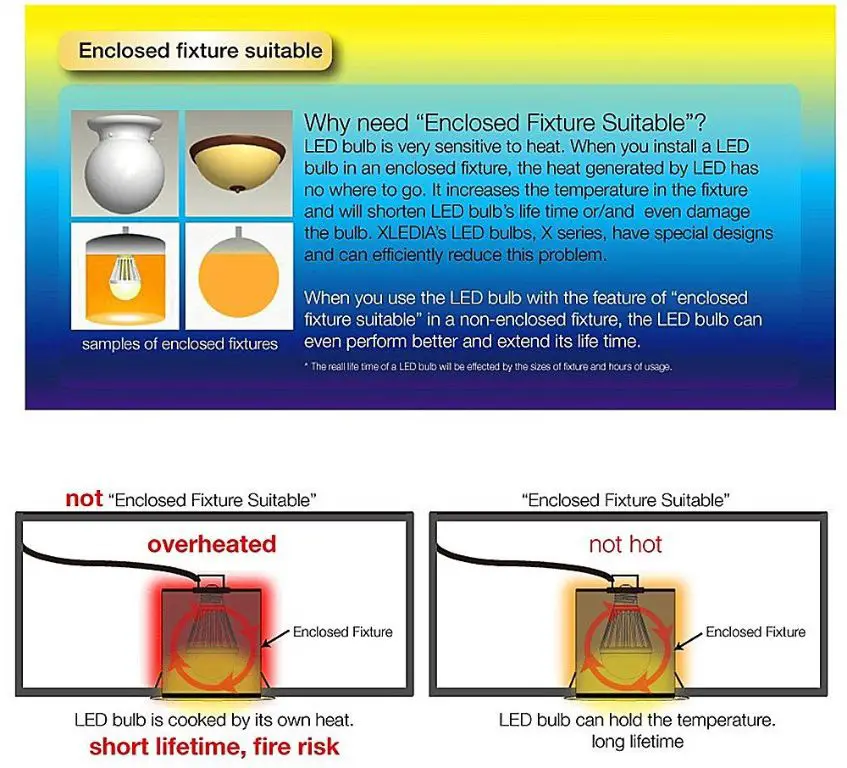Page Contents
Quick Answer
Yes, you can use LED bulbs in totally enclosed fixtures as long as you choose the right type of LED bulb and take a few precautions. The key factors to consider are heat dissipation and dimmability. Most enclosed fixtures trap heat, so you’ll want to choose an LED bulb designed for enclosed fixtures that can handle higher temperatures. You’ll also want to make sure the LED bulb you choose is dimmable if you need to use a dimmer switch. With the right bulb and proper ventilation, LEDs can work well in enclosed fixtures.
LED Bulbs vs. Incandescent and CFL
LED bulbs have several advantages over traditional incandescent and CFL bulbs that make them well-suited for enclosed fixtures:
- LED bulbs run cooler than incandescent and CFL bulbs. They are more efficient at converting energy into light instead of heat.
- LEDs have a longer lifespan. Typical LED bulbs last 25,000-50,000 hours compared to 1,000-2,000 hours for incandescent bulbs.
- LEDs are more durable. Since they don’t have fragile filaments or mercury like CFLs, they can withstand vibration and damp conditions better.
- LEDs reach full brightness immediately without warm-up time.
However, LEDs do have a couple disadvantages:
- LED bulbs can be more expensive upfront.
- LEDs perform poorly with excessive heat. Proper thermal management is important.
Heat Dissipation Concerns
While LED bulbs generate less heat than other bulb types, heat dissipation is still important. LED bulbs are sensitive to high temperatures. Excessive buildup of heat can damage the LED components and cause premature bulb failure.
Enclosed fixtures trap heat since they have limited ventilation. The trapped heat gets transferred to the bulb and socket.
To avoid overheating, choose LED bulbs made specifically for enclosed fixtures. These bulbs are engineered with features to dissipate heat effectively. These features include:
- Ceramic bases or metal core circuit boards instead of plastic.
- Fins or ridges on the housing to dissipate heat.
- Higher operating temperature thresholds (up to 135°C).
Also, make sure the enclosed fixture is not too small for the LED bulb. Allow some space between the bulb and fixture walls (at least 1 inch). This extra room helps airflow.
Under-cabinet lights and recessed downlights are types of fixtures that often need enclosed fixture LED bulbs. Install enclosed fixture LEDs in any fixture where heat is likely to be trapped.
Dimmability Considerations
If you need to use a dimmer switch, choose a dimmable LED bulb. Dimmable LEDs have drivers that are compatible with most standard dimmers.
The dimmer switch model also matters. Older dimmers were designed for incandescent loads. LEDs draw less power, which can cause flickering and buzzing issues with outdated dimmers. Replace very old dimmers or use LEDs verified to work with legacy dimmers.
Check the packaging before purchase to ensure the LED bulb and dimmer switch are compatible. The dimmer switch packaging will indicate “LED compatible.” LED bulb packaging will indicate “dimmable” and often list compatible dimmer switches it’s been tested with.
Bulb Type Comparison
Here is a comparison of common LED bulb types for enclosed fixtures:
| Bulb Type | Pros | Cons |
|---|---|---|
| A-Type |
|
|
| PAR/BR Bulbs |
|
|
| Globe Bulbs |
|
|
| Candle Bulbs |
|
|
For most applications, A-type or PAR/BR LED bulbs offer the best combination of affordability, light output, and energy efficiency. Globe or candle bulbs create mood lighting but don’t offer as much overall illumination.
Recommended Enclosed Fixture LED Bulbs
Here are some top-rated LED bulb options for enclosed fixtures:
| Brand | Model | Key Features |
|---|---|---|
| Philips | 12.5W BR30 Flood LED |
|
| Cree | 100W Equivalent A21 LED |
|
| GE | 100W EQ ST19 Bright Stik LED |
|
| EcoSmart | A19 Dimmable LED |
|
These bulbs are specially designed for enclosed fixture performance, long life, and energy efficiency. Many come from leading brands that back their products with generous warranties. Consider lumens, color temperature, dimmability, and price to pick the right bulb for your needs.
Installation Tips
Follow these tips when installing LED bulbs in enclosed fixtures:
- Read all safety instructions. Turn power off at the breaker before replacing bulbs.
- Make sure the LED bulb is compatible with the fixture. Check wattages and dimensions.
- Only use LED bulbs rated for enclosed fixtures. Avoid standard LEDs.
- Allow space between the bulb and fixture for airflow. Don’t jam in an oversized bulb.
- Add vent holes to severely enclosed fixtures to improve heat dissipation.
- Use LED-compatible dimmers if dimming ability is needed.
- Group multiple lower-wattage bulbs instead of one large bulb to reduce heat.
Following the manufacturer’s recommendations will ensure your LED bulbs for enclosed fixtures operate safely and at full performance.
Proper Maintenance
To keep LED bulbs running smoothly:
- Dust fixtures regularly to improve ventilation and prevent buildup on bulbs.
- Keep fixtures dry to avoid corrosion.
- Avoid touching bulbs so oils from skin don’t impact performance.
- Operate lights on dimmer circuits at over 20% brightness. Dimming too low can damage LEDs over time.
- Replace bulbs immediately if flickering or operational issues occur.
With good airflow and protected from moisture, quality LED bulbs can last years in enclosed fixtures with proper maintenance.
Conclusion
LED bulbs can work very well in enclosed fixtures as long as heat dissipation is properly handled. Choosing bulbs designed for enclosed operation, allowing space for airflow, using compatible dimmers, and following manufacturer guidelines allows LEDs to showcase their long lifespan, efficiency, and performance advantages. With the right LED bulb and some simple installation considerations, enclosed fixtures can be energy-efficient, long-lasting, and bright.
